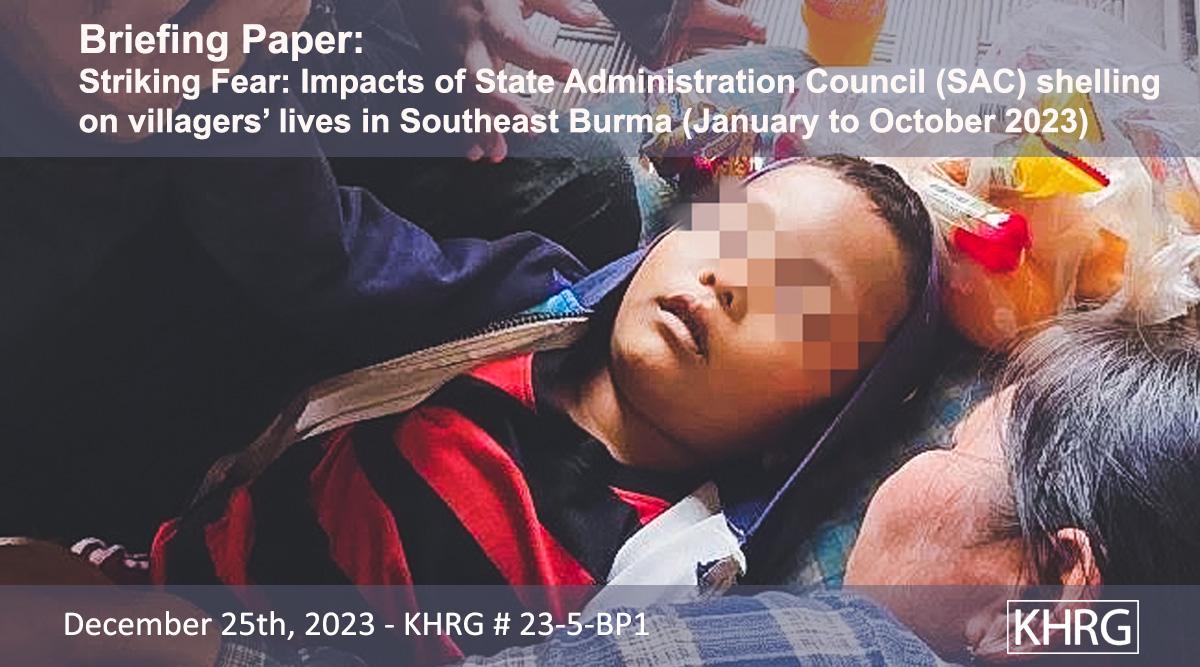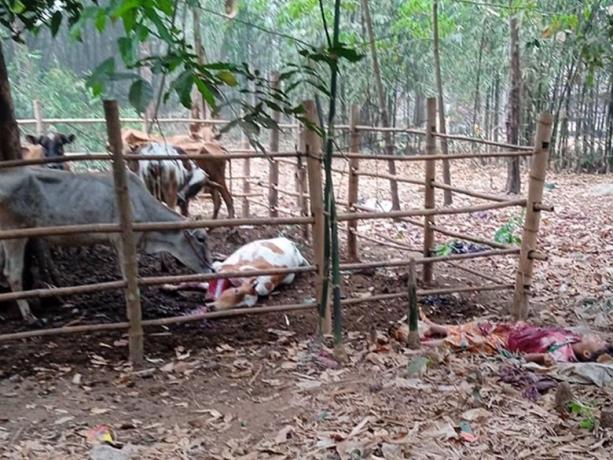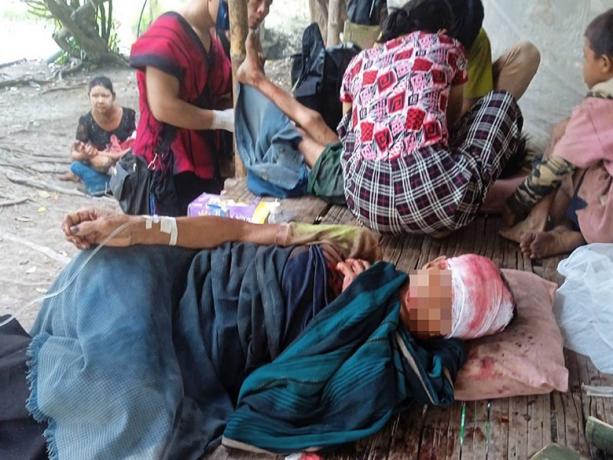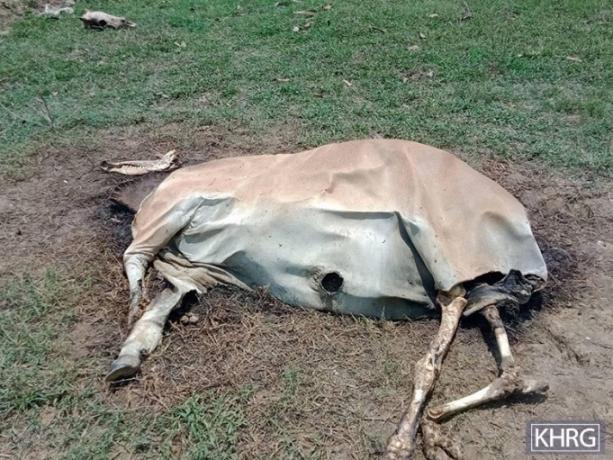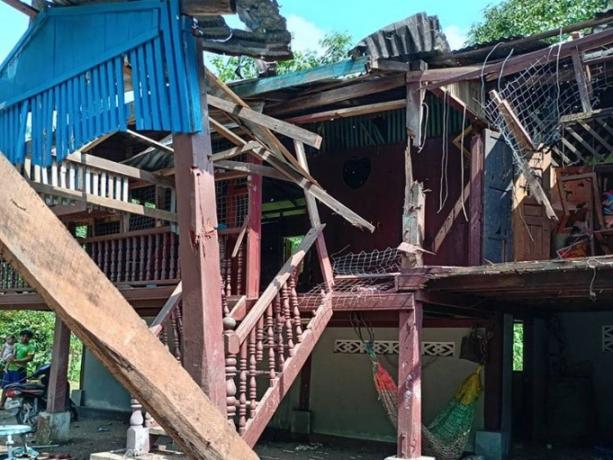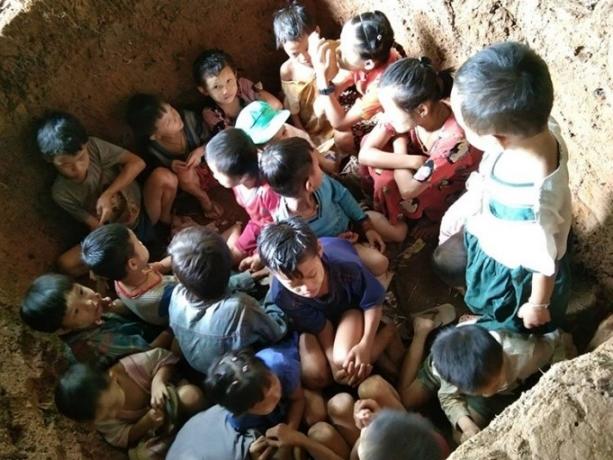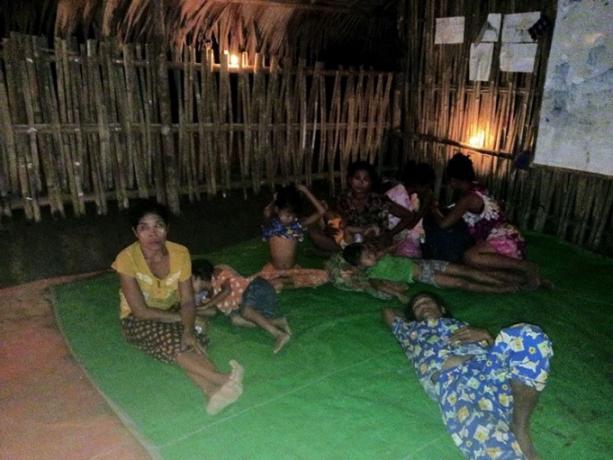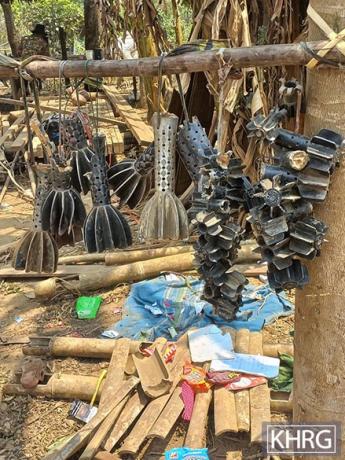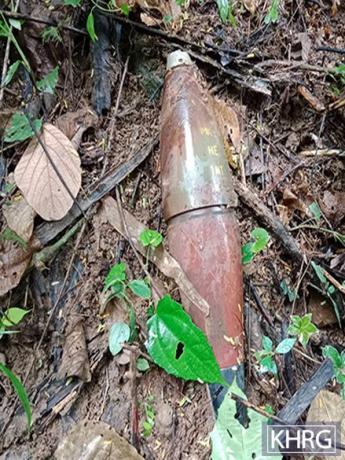Introduction
The villagers in Southeast Burma (Myanmar)[1] have been facing conflict for as long as they can remember. Generations have grown up amidst the fighting, and have lived their whole lives under a fear of attacks. The 2021 coup[2] reinvigorated the open and direct violence of the Burma Army[3], under the command of the State Administration Council (SAC)[4], in locally-defined Karen State[5]. These attacks are deliberately directed towards civilian areas and communities, including by indiscriminately shelling villages and plantations. From January to October 2023 alone, KHRG recorded more than 192 incidents of indiscriminate shelling committed by the SAC, which killed and wounded villagers, destroyed civilian houses, buildings, and plantations, affected livelihoods, and caused displacement.
This briefing paper investigates the consequences of SAC shelling in civilian areas and its impacts on the lives of rural villagers in Southeast Burma. The first section gives an overview of the history of violence and oppression in the region by the Burma Army. The second section presents the immediate consequences of shelling on villagers, including deaths and injuries, the destruction of property, and livelihoods harmed. The third section analyses longer-term impacts, including displacement, persistent fear among villagers, restricted access to education, and the heightened risk of unexploded ordnance (UXOs). Finally, a security and legal analysis of the current situation is conducted, and recommendations addressed to relevant stakeholders are presented.
1. Contextual overview
Locally-defined Karen State has been in ceaseless civil conflict since Burma’s independence in 1948. Since then, the Karen people have been targeted by the Burma Army, who have persecuted and oppressed ethnic minorities around the country and sought to impose military dictatorship. The armed conflict intensified in the early 1990s when the Burma Army, after the nationwide 1988 civilian uprising against military rule, launched an assault that led to the fall of the city of Manerplaw, the former seat of the Karen National Union (KNU)[6] and Karen National Liberation Army (KNLA)[7]. Whilst the 2015 ceasefire agreement brought hopes for peace, Burma Army violence persisted and villagers in Karen State continued to experience oppression, exploitation of resources and cultural persecution.[8] The failed hopes of the ceasefire were compounded when the Burma Army staged a coup against the democratically elected civilian government in February 2021. Since then, as ethnic armed groups and People’s Defence Forces (PDFs)[9] fight the SAC and other affiliated armed groups, civilians in Karen State continue to live in open military conflict.
Throughout this conflict, the Burma Army has frequently conducted indiscriminate shelling into civilian areas to target villagers as part of their “four cuts” strategy to cut ethnic armed groups off from food, funds, recruits and intelligence. The systematic targeting of civilians is sometimes motivated by aims to damage armed resistance forces or punish civilians for supposedly supporting them.[10] Villagers are also targeted arbitrarily and indiscriminately, often with no clear strategic motive. The Burma military’s counter-insurgency operations have involved extrajudicial killings, torture, arbitrary arrests, forced displacements, looting and extortion, sexual violence, forced labour, and since 2021, air strikes. As the level of violence is high, and sufficiently organised armed actors are involved, customary international humanitarian law of non-international armed conflicts can be violated, potentially amounting to war crimes. Furthermore, since widespread and systematic attacks against civilians are being committed, the abuses by the Burma Army can be crimes against humanity under customary international criminal law, in addition to human rights violations.[11]
2. Factual summary: impacts of SAC shelling in Southeast Burma
This chapter presents incidents of shelling by the SAC against civilians from January to October 2023, documented by KHRG in its operational areas.[12] The immediate consequences of such attacks are discussed, as reported by local villagers, including deaths and injuries, the destruction of property, and livelihoods harmed. Longer-term impacts are subsequently analysed, including displacement, persistent trauma and fear, restricted access to education, and the risk of unexploded ordnance (UXOs).
i. Indiscriminate shelling causing civilian casualties
“They [SAC] told us that civilians are also soldiers. They [SAC] said that all the male children will become soldiers in the future, so they pre-shelled [killed villagers]. They [SAC] said they would shell [to kill villagers] to reduce the number of villagers, if not there will be more army [local resistance soldiers]. So, they commit indiscriminate shelling.”
Testimony of Saw A---, a villager from Kyauk Sa Yay village tract, Ler Doh Township, Kler Lwee Htoo District, whose 16-year-old son was killed by SAC shelling.
Death and injury are two of the main consequences of the SAC’s both indiscriminate and targeted shelling into community areas, which land and explode in and around villages, farms and plantations. The Burma Army regularly fires mortar shells into villages during military operations, such as after skirmishes with armed resistance groups or when sending new troops, ammunition or rations to front-line army camps. Shelling happens everyday across the seven Districts of locally-defined Karen State, but there are days when a large number of mortars are shelled indiscriminately, with particular intensity. SAC shelling threatens villagers in their daily lives; it happens when children are studying at school or playing games, when villagers are hunting wild animals to eat, collecting firewood, working on farms or plantations, or when they are in their houses. Mortar shelling causes both an immediate risk to life and long-term impacts on local villagers.
a) Deaths caused by SAC shelling
Shelling by the SAC in Karen State causes many civilian deaths. In this year alone, from January to October 2023, KHRG received information of 58 people killed by SAC shelling, of whom 17 were children. For instance, on January 14th 2023, at 1:15 am, SAC soldiers from Light Infantry Battalion (LIB)[13] #407, based at Ma Htaw army camp, fired 81mm mortars into the village communities. One mortar landed on a farm in Ca--- village, Meh Klaw village tract village tract, Dwe Lo Township, Mu Traw District, where the farm owner, Saw Aung (38 years old) was sitting in his farm hut waiting to herd his buffaloes. Shrapnel hit his left cheek, neck and thigh, and killed him instantly. LIB #407 is under the command of Operation Commander That Pin Kyaw. Another incident happened on March 6th 2022 at 12 am, where LIB #408, based in Khaw Thoo Pwah army camp, Ma Htaw village also shelled 81 mm mortars into the communities. One of the mortars landed beside the house of 37-year-old villager Saw Ab---, in Cb--- village, Ma Htaw village tract, Dwe Lo Township. He was hiding under his house when shrapnel hit him. Villagers tried to take him to Cc--- Hospital to receive medical treatment, but he died on the way before he reached the hospital because of the severity of his injuries and the long distance to travel. Saw Ab--- is survived by four family members; his young children and his wife had been relying on him for their family’s livelihood and do not have access to any support. SAC LIB #408, who committed this attack, is led by Battalion Commander Zaw Min Htet, which is also under the command of SAC MOC #8.
SAC soldiers often shell villages after skirmishes with armed resistance groups. On June 17th 2023, the SAC based close to Cf--- village, Sa Pa Gyi village tract, Daw Hpa Hkoh Township, Taw Oo District, shelled 60mm mortars into the villages around their army camps after being attacked by local KNLA troops. One mortar landed in a village beside Saw Af---‘s house in Cf--- village. The shrapnel killed his mother-in-law: it hit her head and chest. Saw Af--- was also injured over his whole body. Similarly, on June 29th 2023, at 6pm, SAC Infantry Battalion (IB)[14] #283 based in a place near Thon Taing village, shelled mortars into Cg--- village, Noh T’Kaw village tract, Noh T’Kaw Township, Dooplaya District, after they were attacked by KNLA Battalion #17, Company #2, and People’s Defence Force (PDF), by drone. The next day, on July 30th 2023, SAC IB #283 shelled mortars again, and shrapnel hit the head and arm of a 44-year-old villager, Saw Ag---. He was found dead by the villagers only the next morning when they returned to the village.
Many times, SAC soldiers directly shell into civilian areas without apparent motive. For instance, on August 13th 2023, at 5pm, SAC LIB #264 based in Pay S’Loh army camp, shelled mortars into a villager’s garden and close to villagers’ houses in Ch--- village, Kyauk Z’Yit village tract, Ler Doh Township, Kler Lwee Htoo District. As a result, shrapnel killed two children: a 16-year-old boy called Saw Ah--- who was hit on the head, near the ear, and a 12-year-old boy named Saw Ai---. Shrapnel also injured two girls, 14-year-old Aj--- and 10-year-old Naw Ak---. Villagers sent the two girls to a local clinic for treatment. According to Saw Al---, the father of one of the victims, “The sound came from the sky then landed there [beside his house]. We saw smoke. Then, we heard villagers’ screaming so we ran there, and we saw the children injured. […] The [two boys] got injured and [one] died instantly. The other one [was still] alive for half an hour before dying.” After the incident, a local leader expressed his emotions to Saw Al---: “Ooooh!! How can they [SAC] do this to us? We do not know where it came out from; we just heard the sound from the sky. We are not even sure what it is.”
b) Injuries caused by SAC shelling
Explosions from the mortar shells, the debris scattered, and the shrapnel, all cause injuries among villagers. According to KHRG documentation, 242 villagers were injured by SAC shelling between January and October 2023, of whom 57 are children. Between January and March 2023, SAC troops operating in Hsaw Htee Township shelled about 300 mortars around their operational area. Shrapnel from these mortar shell explosions injured five villagers and killed two villagers. Before 2023, five SAC troops were operating in this Township: IB #57, and LIBs #589, #598, #350 and #349. From January 2023 onwards, the SAC strengthened its military activities by sending more troops, including LIB #264 and IBs #20 and #91, and Divisions #77, #88, #44 and #33. The SAC also set up more artillery shelling points in many places to easily shell mortars in the area around their base.
On March 25th 2023, fighting broke out between KNLA and PDF combined forces and the SAC, at the SAC police office in Kyon Don Town, Kru Tu Township, Dooplaya District. In retaliation, at about 7:30 am, SAC LIB #546 (under MOC #12), based in Kyon K’Lay military camp, indiscriminately shelled 120mm mortars in the areas around the army camp. Some mortar shells landed in Cj--- village, Kaw Wah Leh village tract, Kru Tu Township, Dooplaya District. The shrapnel hit 15-year-old Saw Ao--- on the neck, killing him instantly. The next day, on March 26th 2023, at about 10 am, the same SAC troops shelled mortars into Kyon Don Town again. Shrapnel from these shells injured 16 villages and damaged 39 houses in Kyon Don Town, including 67-year-old villager Daw Ap---. After this incident, other villagers helped her by taking her to the Kyon Don hospital but she passed away due to her injuries and her underlying heart condition.
Injuries caused by indiscriminate shelling are not only life-threatening but cause an enormous impact on victims’ family members. In March 2023, SAC soldiers from IB #285 based in P’Law Kon army camp, Aww Poo area, Ler Muh Lah Township, Mergui-Tavoy District, also shelled mortars into Ck--- village. The mortars landed near a group of villagers playing volleyball and shrapnel injured four of them. The four injured villagers were Saw Aq---, Saw Ar---, Saw As--- and Saw At---. Saw At--- sustained serious injuries to his abdomen and his hand, so other villagers sent him to the hospital in Cl--- village, P’Law area, Ler Muh Lah Township. The hospital then transferred him to the hospital in Cm--- Town the next day. The family paid around 3 million kyat [1,429 USD][15], but the actual cost of medical treatment was higher, and so his family members subsequently faced major financial difficulties. His wife was left alone to take care of their seven children whilst he recovered from his injuries. The three other villagers sustained only minor injuries, so they were able to receive medical treatment at the village clinic. Similarly, on June 15th 2023, at about 11pm, the SAC from Shan Say Bo army camp shelled mortars into Cn--- school campus, Co--- area, Htaw T’Htoo Township, Taw Oo District, without prior skirmishes or other military movements occurring. One of the mortars landed in a kitchen near a student dormitory. Three female students were injured by shrapnel, and they were sent to the school clinic for medical treatment. One of the three students sustained serious injuries and the local clinic did not have sufficient medical supplies, so health workers had to buy the required medicine from Taw Oo Town.
On June 16th 2023, the SAC troops based in Thein Za Yah Town police station shelled five 60mm mortars on Road No. 8, Cp--- Section, Cq--- Town, Kyeh Htoh Township, Tha Htoo District, which landed near the house of U Au--- and the house of U Av---. The shrapnel injured family members from these two households. U Au--- (34 years old) was injured on his hand, and his five-year-old daughter was injured in the face. His wife Ma Aw--- (38 years old) was killed by the shrapnel. The shrapnel also injured U Av--- (35 years old) and his wife Daw Ax--- (36 years old) on their arms. They received medical treatment at their nearby clinic. One of the five mortars remained unexploded. On June 17th 2023, SAC Artillery Unit #310, under LID #44, came to the village to pick up this unexploded ordnance and claimed that the shelling had been conducted by local resistance armed groups. On July 7th 2023, at 11:05 am, SAC LIB #314 based in Kyaw T'Raw army camp, Kyaw T’Raw village, Shwe Yaw Pya village tract, Bilin Township, shelled mortars in Cr--- village. The shrapnel injured six villagers; one man (Saw Ay---, 25 years old), two children (Saw Bm---, 5-year-old boy, and Saw Bn---, 9-year-old girl), one teenager Naw Bo---, an 18-year-old girl, and two women (Naw Bk---, 58 years old, and Naw Bl---, 57 years old). Villagers helped by providing emergency first aid and transportation to the local clinic so that the victims could access medical treatment in the Cs--- clinic under KNU territory.
|
Human rights defenders at risk Fighting often happened between the SAC and the KNLA during October and November, 2023 in Ct--- village tract, Kaw T’Ree Township, Dooplaya District. On November 12th 2023, having been informed by local village leaders of events, 28-year-old Saw Az---, a local human rights defender, went to K'Nae Lay village, Maw Hkee village tract, to document the human rights situation. At 9:30 am, SAC IB #32, led by Company Commander Kyaw Zin Oo, indiscriminately shelled mortars into the village again. As explained by a community member, "They [SAC] fired mortars like rain". Saw Az--- was hit and seriously injured in his right eye by a mortar explosion. A piece of shrapnel was lodged in his right eye. That same day, he was sent to Cu--- Hospital, in Thailand. He was transferred to different hospitals in Thailand and finally, his right eye had to be removed.
Saw Az---’s family members felt very sad about what happened to him. His sister explained: “I really feel sorry about what happened to my brother but we cannot do anything about it. […] As he lost his right eye, he will face many challenges in the future. For example, he won’t be able to see things clearly [properly] like before. […] Even though we feel sad about it, we have to accept this situation. I think it will not be easy for him to do things [in] whatever he does in the future”. |
ii. Damages caused by shelling
The SAC has constantly and deliberately fired into civilian areas in rural Southeast Burma since the 2021 coup, causing enormous destruction and damages to civilians’ housing, infrastructure, property, resources, including farming structures, and crops. From January to October 2023, KHRG documented at least 166 damaged houses and 64 houses completely destroyed. This brings livelihood challenges and other long-term issues to their owners’ lives. Out of 192 total reports, 25 mentioned that plantations had been damaged or destroyed in the shelling. Other livelihood sources like animal farming were also attacked, with at least 36 livestock killed and 26 wounded.
a) Attacks on civilian infrastructure and livelihoods
The damages and destruction on local villages varied from one instance of shelling to another: some caused profound damage to the buildings and casualties whereas some did not. This is due to the indiscriminate nature of these attacks, directed towards civilian areas. In one instance, on March 13th 2023, in Aw P’Lah and Nyaung Pin Gyi village tract, Ler Doh Township, SAC soldiers based in Mi Laung Kon and Western Pyay Yay villages conducted shelling that caused significant destruction and damage to housing . They shelled around 25 mortars into the eastern side of Pyay Yay village, Nyaung Pin Gyi Ywa Thit and Aww P’Lah (Ain Ba La) village, destroying several villagers’ houses. The shelling destroyed six houses, destroyed two rice barns and one tractor, and killed one cow in Aww P’Lah Village, Aw P’Lah village tract. The SAC soldiers also burned villagers’ houses down after the shelling, showing the intentionality of destruction. Due to the incident, a total of 4,327 villagers from the six villages fled and sought refuge in different villages in Ler Doh Township. By March 25th 2023, some villagers had returned to their villagers but some did not dare to return yet.
Rural villagers in Southeast Burma mainly secure their livelihood with agricultural plantations and farming, which are usually located near the village or within it. Therefore, when shelling is conducted on a village, it also damages the plantations and livelihood materials. This makes it harder for villagers to secure their livelihood. The shelling in Nyaung Pin Gyi Ywar Thit village, Pyay Yay village tract, Hsaw Htee Township, Kler Lwee Htoo District, on February 23rd 2023 burnt down a house and destroyed a rice husker machine. On February 2nd 2023, at 8pm, SAC soldiers based at K’Hser Theh Pleh army camp fired several rounds of 120 mm mortar into the vicinity of Htee Law Thee Hta village, Htee Th’Bluh Hta village tract, Dwe Lo Township, Mu Traw District. This destroyed the paddy fields, as well as three betel nut plantations owned by villager named Saw Ba---. Due to this incident, villagers remain fearful to return to work on their farmlands.
In February 2023, SAC LIB #409, #406, #405 launched further intense military attacks on civilians and their property with indiscriminate shelling, looting, destruction and burning in several villages throughout Meh Way village tract, Dwe Lo Township. The damages caused by shelling in Hkloh Hkee village alone amounted to at least three houses, 110 large tins of paddy seeds, 17 large tins of rice, 1 generator, 1 water machine, 1 car, 1 motorcycle, 1 solar panel, 1 battery, 2 loud speakers, 120 plates, 14 pots, 16 blankets and 3 metal box. These were owned by three villagers in the Hkloh Hkee village. In another instance, on July 27th 2023, at 4:55 am, fighting happened between the SAC and KNLA in Wee Raw area, Tha Htoo Township, Doo Tha Htoo District. Following this, SAC IB #9 shelled several rounds of mortars from 5am to 10:30am into the local villages, causing huge destruction and many casualties. Nine mortar shells landed in Htoh Kaw village, injuring four villagers. Nine other mortar shells also landed at a place between Htee Ter Day and Way Raw villages, another five at Nya Htee Kyo place, and another four at Mee Chaw Kon place. Five mortar shells also landed at T’Rweh Kloh Nee place, and another fourteen mortar shells in Way Raw village, causing extensive damage to villagers’ housing and community buildings. These attacks completely destroyed four houses and damaged nine other houses, two cars, killed one cow and injured five more.
Animal husbandry and cattle farming are an important source of livelihood for rural villagers. Villagers raise their cattle and livestock in their gardens and farms, as well as keeping buffaloes and chickens. When the shelling damages or destroys houses, it often also injures or kills livestock. As reported to KHRG, the SAC indiscriminately shelled into a village following fighting near Cg--- village area, Cg--- village tract, Noh T’Kaw Township, Dooplaya District on January 4th 2023. This killed a villager’s cow and damaged the household’s property. Shortly after the shelling, some SAC soldiers came to the owner’s house, tortured and threatened him against reporting the incident to anyone. Another incident happened on July 27th 2023, when SAC IB #9 shelled Way Raw village, Way Raw village tract, Thaton Township, destroying houses and property, killing one cow and injuring 5 cows owned by the local villagers. Also in Na Kyat A’Htay village, Special area, Daw Hpa Hkoh Township, Taw Oo District, SAC LIB #304 shelled into the village, injuring some villagers’ cattle on August 26th 2023.
At great risk to life, some villagers try to protect their properties in the midst of shelling from SAC. On May 14th 2023, at 7pm, SAC soldiers based in Hlaing Wa's new army camp, IB #97, indiscriminately fired 60mm mortar shells into Naung T’Lar village, Pa Kyar village tract, Kyonedoe Township, Dooplaya District and damaged U Lar Lu’s house. On May 15th 2023, at 4pm, the same SAC unit indiscriminately shelled mortar shells again, which damaged and burned U A’Thaw’s house. Nearby villagers tried to stop the fire, but half of the house was already burnt. None of the house’s occupants were injured by the shelling as villagers had already fled to another Township due to a previous indiscriminate shelling incident earlier in 2023, and had not returned to live in the village yet.
b) Destruction of community buildings
Community buildings such as schools, clinics, monasteries and churches are also attacked by the SAC. Shelling damages community buildings in rural areas, which violates villagers’ access to health, education and their rights to religious participation. For instance, on July 28th 2023, at 8pm, SAC battalion LIB #590 indiscriminately shelled into Htee Toh Loh village, Paw Pee Der village tract, Moo Township, Ker Lwee Htoo District, damaging Htee Toh Loh’s building and a nursery school of the organisation Early Childhood Care and Development (ECCD). SAC shelling on July 27th 2023 in Way Raw area, Tha Htoo Township, Doo Tha Htoo District, also damaged community infrastructure including an entranceway and two buildings of a monastery, and one clinic. On May 27th 2023, a monastery in Kwee Hkler village, Htaw Wah Law village tract, Kaw T’Ree Township, Dooplaya District, was also damaged by shelling by SAC IB #558, that based in Poh Chi Mu army camp.
iii. Long-lasting impacts of SAC shelling
a) Displacement
“We are so scared of the mortars and guns, so we ran into the nipa palm trees when hearing the sounds of shelling. We had to crouch in the water so that the soldiers wouldn’t see us. It was so devastating. We have seen people displaced on Facebook [posts] but we never thought this would come to us. We had to survive it horribly.”
A displaced villager from Kleh Muh Htee area, K’Ser Doh Township, Mergui-Tavoy District
Displacement is the most common consequence of SAC indiscriminate shelling, used as an agency strategy by villagers to avoid injury and death. According to KHRG documentation, at least 22,759 villagers were displaced by SAC shelling from January to October 2023. They flee for their safety to hidden places in the forests and jungle, leaving behind their homes, property, and livestock. Some villagers can return to the village after a few days, but other times the shelling continues for a long period and people never dare to return. Some villagers also try to settle close to the Thai-Burma border and cross it temporarily to take refuge during times of armed conflict.
When shelling takes place in one village, it also raises the security concerns for other surrounding villages, as they can hear the shelling explosions nearby. It usually leads to the displacement of more than one village, sometimes up to the whole village tract in the incident area. On April 9th 2023, from 9:20am to 4:10pm, SAC troops based in P’Nweh Klah army camp shelled six mortars into several villages in Maw Lay village tract, near the army camp. Three mortars landed in Noh Thay Hkoh place, near Koh Daw Nee village, Maw Lay village tract, Thaton Township, Doo Tha Htoo District. Shrapnel injured the left leg of a child called Saw Bb---, from Cv--- village. One mortar landed in Noh Htoh Day village, damaging 4 houses and injuring one villager, Naw Bc--- (38 years old), on her thigh, breaking her right leg. Due to this incident, many villagers in Maw Lay village tract did not feel secure to live in the village any longer, so they fled. Even after villagers were displaced to the forest, the SAC continued to shell to make villagers unable to return.
In some cases, SAC troops from different army bases collectively attack several villages. These large-scale incidents cause massive displacement of civilians. For instance, from March 9th to 12th 2023, tens of thousands of villagers from Hsaw Htee Township, Kler Lwee Htoo District, had to flee due to the increased indiscriminate shelling and militarisation. On March 12th 2023, the SAC’s united forces of LIB #20, Division #77, #88, #44, #33, IB #57, and LIBs #350 and #264, indiscriminately opened fire into Sat Su and Thet Kel Kone villages at 3:45am. On the same day, they shelled more than 200 mortars from 5am to 11am into Sa Su village, Thet Kel Kone village, Nyaung Pin Gyi Ywar Thit village, Thaik Tu Kon village, Waing Kyon village, and Pyay Yay village, where civilians were taking shelter. The residents of these six villages fled to Aay Kah Neeh Kyawh Tah, Shwe Kyin, Ma Daut, and Nyaung Lay Pin Towns. The SAC entered some villages and looted and destroyed the villagers’ belongings. At least 11,646 villagers have been displaced by SAC shelling in Hsaw Htee Townhsip, Kler Lwee Htoo District, since March 9th 2023. This displacement in Hsaw Htee Township continued to impact villagers’ security, food supply and livelihood as most displaced villagers could not return home, only a few families returned to take care of their home temporarily. Since the SAC continues to be present in Kaw Loh Kloh River area, local villagers are concerned that the armed conflict will become more intense.
b) Long-term livelihood impacts
The armed conflict and the attacks by the SAC are putting villagers’ livelihoods and well-being at risk, as many no longer feel safe enough to work on their plantations. In Moo Township, Kler Lwee Htoo District, for instance, some villager’s plantations are located near the SAC army camp. In particular, SAC LIB #60, #351, #599 and #590, in Htee Toh Loh army camp, Mon Ton army camp, Aoh Pyat Ton army camp, Thit Cha Sait’s army camp and Than Bo army camp are located close to farmers’ plantations. When they see villagers working on the farms, they fire mortar shells and artillery. This threatens villagers and their ability to farm.
In some cases, shelling kills families' breadwinners, leaving the remaining relatives to face livelihood hardships. In Cz--- village, P’Law area, Ler Muh Lah Township, Mergui-Tavoy District, a man named Saw Bd--- was killed by SAC LIB #285 shelling on July 25th 2023, and his house was damaged. He is survived by his wife and son. His wife Naw Be--- faced livelihood challenges and had to stay with her relatives.[16]
c) Psychological impacts
Due to constant shelling causing injuries and deaths in their villages, villagers are overwhelmed by fear. More than half of the villagers whose testimonies are included in this briefing paper explicitly expressed themselves being in fear because of shelling. For instance, a villager in Cg--- village, Cg--- village tract, Noh T’Kaw Township, Dooplaya District, described: “This kind of incident has an impact on villagers both physically and mentally. We always think about when the shelling will happen. Our fear is increasing gradually. […] Some villagers have plans to relocate to another area. We are unable to predict the situation, so we just live in our village and wait to see what happens. We are in fear and face challenges. It is difficult for us to relocate because it is far and challenging to travel. […] As civilians, we want to have the freedom to travel, work, and live. We want to live our lives without fear. We want human rights organizations and international leaders [stakeholders] to consider us and have better plans for our people.”
In order to avoid casualties, some local villagers dig bunkers and hide underground during shelling, or flee to the forest. Villagers usually prepare food immediately to bring to the forest when they hear the sound of shelling.
d) Impact on access to education
Shelling incidents also result in hurdles to access education as villagers have to flee often. Some villagers had to flee to their plantation huts or the jungle to avoid shelling in the village. When this happens, children cannot go to school. Some communities organised reading clubs for students to study alongside one another when self-studying when in-person schooling is not possible. Some villages still have operational schools run by the Karen Education and Culture Department (KECD)[17].[18] In villages where schools occasionally open, parents are very afraid and anxious to let their children go to school, due to unpredictable outbreaks of shelling in the area.
e) Unexploded ordnances (UXOs)
In some occasions after SAC shelling, mortar shells or bullets remain unexploded when they fall. Some of the unexploded mortars cannot easily be found. UXOs pose a high risk to villagers’ lives and security, as the mortars can explode at any time.
On March 25th 2023, SAC LIBs #275 and #355 and IB #88 indiscriminately shelled mortars into Thit Kar Nyee Naung and Meh K’Neh villages, Noh Poe village tract, Kaw T’Ree Township, Dooplaya District, causing damages to the house. Some shells remained unexploded, posing great risk to villagers. In another instance, on July 2nd 2023, at about 10 am, SAC soldiers from LIB #407 based in Ma Htaw village, Ma Htaw village tract, Dwe Lo Township, Mu Traw District, indiscriminately fired three rounds of 120mm mortars into Meh Hkuh Hta village, Meh Hkuh village tract, Bu Tho Township, Mu Traw District. With the explosion, the rooves of Naw Bf--- (45 years old) and Naw Bg---’s houses were destroyed. The SAC fired three mortars and only two of them exploded; another remained unexploded. Villagers could not find the unexploded mortar. Therefore, about 300 villagers are living in fear of the SAC’s indiscriminate shelling, and the remaining UXOs.
Some local villagers in rural areas are not fully aware of the risks posed by UXOs. Children especially are at high risk. For instance, Thar Yar Kon village, Maung Ma village tract, Kaw T’Ree Township, Dooplaya District, is an area where shelling and fighting frequently happens since the 2021 coup. On January 26th 2023, two children, Saw Bh--- and Saw Bi---, found an unexploded mortar in Thar Yar Kon village. At first, these two children thought that this mortar remained from an air strike bomb, so they took it to the village to show other people who might know about it. Saw Bh--- put the mortar into his pocket and showed it to a villager named Saw Bj---. When Saw Bj--- saw it, he knew that it was an M40 mortar, gold colour, still unexploded. Saw Bj--- knew it was dangerous, so he suggested Saw Bh--- to return the M40 mortar to the place where he took it. When an aunt of Saw Bj--- saw the children holding a mortar, she shouted loudly, "Where did you get it?". The child, Saw Bh---, was startled and the mortar fell to the ground and exploded.
Saw Bi--- and Saw Bh--- were blown to the ground on the place where they were standing after the mortar exploded, and their bodies were covered with injuries. Saw Bj--- was injured on both of his legs, and his aunt’s face also was injured. Saw Bj--- and his aunt sustained fewer injuries, because they were standing further away from the two children. Saw Bh--- died shortly afterwards. The three other injured people were sent to Kho Ther See Ther Plur village, Kho Ther See Ther Plur village tract, for treatment.
3. Analysis: Legal implications of widespread and systematic SAC shelling
Indiscriminate shelling is the most common form of attack used by the SAC against villagers in Southeast Burma since the 2021 coup. Between January and October 2023, KHRG documented at least 192 instances of shelling, in which more than 812 shells were launched, across KHRG operational areas. Often, SAC shelling into civilian areas occurred after skirmishes with armed resistance groups, when the SAC know resistance groups are active in an area, or before carrying out regular SAC military activities such as the transport of rations, soldiers and weapons between their army camps. In other cases, the SAC simply shells indiscriminately into villages and plantations to threaten and scare the local population. Hence, shelling is another mode by which the SAC is deliberately targeting the civilian population in Karen State.
Civilian lives and security are highly threatened by this shelling. KHRG documented a total of 58 persons killed, including 17 children, and 242 people injured, including 57 children. These villagers were hit by shelling when they were asleep, hiding, or staying at home. Other villagers were hit when they were working on their plantations and travelling between villages. Most injured villagers were not able to access urgent medical care immediately, contributing to their deaths. Some villagers were killed by shelling instantly. Shelling also destroyed and damaged their houses, community buildings, religious buildings and plantations.
Displacement is the most common agency strategy to survive shelling incidents. Due to the constant displacement caused by indiscriminate shelling, communities as a whole cannot work on their agriculture plantations and take care of their crops to secure their families’ livelihoods. This also results in food shortages for rural villagers. It is also at a high risk to their lives that they sneak back into the village to withdraw some food and household items after fighting happened. Villagers’ livelihoods are also highly impacted when they are unable to resume work after being injured. The local villagers who experienced constant shelling remain in fear and continue to face threats to their lives no matter whether they stay in the village or displaced. Some shells remain unexploded after falling into the local villages, plantations and around the community area. Children are at most high risk of being killed or injured by the UXOs, as they are not aware of their inherent danger.
All of these abuses happen in violation of international law. One of the most basic rules of the law of armed conflict is that military personnel and objectives must be distinguished from civilians and their possessions.[19] This distinction is crucial, as only military targets can be attacked, whereas civilians are protected.[20] As a result, in their operation, militaries have to use adapted weapons that can ensure their target is adequately impacted, to guarantee that their attacks are not indiscriminate.[21] In most cases, instead of trying to respect the law, the SAC purposefully and knowingly violates all of these most fundamental rules by intentionally targeting civilians, civilian settlements, property, villages, plantations and fields. By doing this, the military ensures that their victims will be civilians, in blatant disrespect for international law standards. This behaviour amounts to war crimes.[22]
Furthermore, shelling villagers leads to a number of consequences for villagers. Since most villagers are forced to displace, the intentional use of shelling against villagers could amount to the crime against humanity of forcible transfer of population.[23] Other consequences for villagers include struggles to maintain their health, education, and livelihood. These constitute various violations of customary human rights standards. The SAC should be incriminated for these violations in order to fight impunity, establish responsibility, and implement reparations for the individuals and communities faced with these crimes.
Recommendations
For international stakeholders, INGOs, and regional and foreign governments:
- Acknowledge that the military junta is the reason for the current human rights and humanitarian crisis, and abstain from giving legitimacy to the junta, including by signing agreements with them and presenting them with credentials.
- Seek justice and hold the SAC accountable for their use of indiscriminate shelling into civilian areas, by prosecuting SAC leaders in international courts, including at international criminal court (ICC), and through universal jurisdiction proceedings.
- Broaden the scope of international investigations to include human rights the abuses faced by the Karen people, especially in regards to the malevolent use of indiscriminate shelling to target them.
- Support local civil society (CSOs), community-based organisations (CBOs) and ethnic service providers who are currently assisting victims and their families to recover and cope with the impacts of shelling by the SAC, as well as helping displaced and fleeing villagers.
- Implement further coordinated and strategic sanctions on the SAC, junta officials, and weapons/shelling suppliers, to weaken the junta’s capability to finance their campaigns and attacks on civilians.
Footnotes:
[1] In 1989, the then-ruling military regime changed the name of the country from Burma to Myanmar without consultation from the people. KHRG prefers the use of Burma because it is more typically used by villagers, and since the name change to Myanmar is reflective of the military regime’s longstanding abuse of power.
[2] On February 1st 2021, the Burma Army deposed the democratically elected government led by the National League for Democracy (NLD), transferred power to Min Aung Hlaing, the Commander-in-Chief of Myanmar’s Armed Forces, and invalidated the NLD’s landslide victory in the November 2020 General Election.
[3] The terms Burma Army and SAC are used interchangeably throughout this report to describe Burma’s armed forces. Villagers themselves commonly use Burma Army, Burmese soldiers, or alternatively the name adopted by the Burma military regime at the time - since the coup, the State Administration Council (SAC).
[4] The State Administration Council (SAC) is the executive governing body created in the aftermath of the February 1st 2021 military coup. It was established by Senior General Min Aung Hlaing on February 2nd 2021, and is composed of eight military officers and eight civilians. The chairperson serves as the de facto head of government of Burma (Myanmar) and leads the Military Cabinet of Burma, the executive branch of the government.
[5] Karen State, or Kaw Thoo Lei, as defined by the Karen National Union (KNU), covers Kayin State, Tanintharyi Region and parts of Mon State and Bago Region. The KNU uses different boundaries and location names for the areas under its control, dividing Karen State into seven districts. Karen State, located in Southeastern Burma, is primarily inhabited by ethnic Karen people. Most of the Karen population resides in the largely rural areas of Southeast Burma, living alongside other ethnic groups, including Bamar, Shan, Mon and Pa’Oh.
[6] The Karen National Union (KNU) is the main Karen political organisation. It was established in 1947 and has been in conflict with the Burma government since 1949. The KNU wields power across large areas of Southeast Burma and has been calling for the creation of a democratic federal system since 1976. Although it signed the Nationwide Ceasefire Agreement in 2015, relations with the government remained tense. Since the 2021 coup, it has been in open armed conflict with the State Administration Council (SAC).
[7] The Karen National Liberation Army is the armed wing of the Karen National Union.
[8] KHRG, “Beyond the Horizon: Local Perspectives on Peace, Justice and Accountability in Southeast Myanmar”, September 2019.
[9] The People’s Defence Force (PDF) is an armed resistance established independently as local civilian militias operating across the country. Following the February 1st 2021 military coup and the ongoing brutal violence enacted by the junta, the majority of these groups began working with the National Unity Government (NUG), a body claiming to be the legitimate government of Burma (Myanmar), which then formalised the PDF on May 5th 2021 as a precursor to a federal army.
[10] KHRG, ““Why would they target us?”: Exploring patterns of the Burma Army's retaliatory abuses against villagers across Southeast Burma”, June 2023
[11] KHRG, “Undeniable: War crimes, crimes against humanity and 30 years of villagers’ testimonies in rural Southeast Burma”, December 2022.
[12] KHRG operates in seven areas in Southeast Burma: Doo Tha Htoo (Thaton), Taw Oo (Toungoo), Kler Lwee Htoo (Nyaunglebin), Mergui-Tavoy, Mu Traw (Hpapun) and Dooplaya and Hpa-an. When KHRG receives information from the field, it organises data according to these seven areas. These are commonly referred to as ‘districts’ and are used by the Karen National Union (KNU), as well as many local Karen organisations, both those affiliated and unaffiliated with the KNU. KHRG’s use of the district designations in reference to our research areas does not imply political affiliation; rather, it is rooted in the fact that many rural communities commonly use these designations. For clarity, the Burmese terms for these districts are provided in brackets but do not correspond with the Burma (Myanmar) government administrative divisions.
[13] A Light Infantry Battalion (LIB) comprises 500 soldiers. However, most Light Infantry Battalions in the Burma military are under-strength with less than 200 soldiers. Yet up-to-date information regarding the size of battalions is hard to come by, particularly following the signing of the 2015 Nationwide Ceasefire Agreement (NCA). LIBs are primarily used for offensive operations, but they are sometimes used for garrison duties.
[14] An Infantry Battalion (IB) comprises 500 soldiers. However, most Infantry Battalions in the Burma military are under-strength with less than 200 soldiers. Yet up to date information regarding the size of battalions is hard to come by, particularly following the signing of the NCA. They are primarily used for garrison duty but are sometimes used in offensive operations.
[15] All conversion estimates for Kyat in this report are based on the official market rate as of December 22ndth 2023 at 1 USD = 2,102.68 MMK, conversion rate available at https://www.xe.com/currencyconverter .
[16] KHRG, “Mergui-Tavoy District Incident Report: Two villagers killed and two injured by the SAC shelling in Ler Muh Lah Township, July 2023”, November 2023
[17] The Karen Education and Culture Department is the education department of the Karen National Union. Its main goals are to provide mother tongue education services to rural Karen populations in Southeast Myanmar, as well as to preserve the Karen language, culture and history. Despite being an important education provider in the region, it is not officially recognised by the Myanmar government.
[18] See, for example: KHRG, “Taw Oo District Situation Update: SAC indiscriminate shelling causing death and injury, travel restrictions, and villagers’ livelihood, education, and healthcare challenges, from January to March 2023.”, November 2023; KHRG, “Statement on International Day to Protect Education from Attack”, September 2023.
[19] Rules 1 and 7 of Customary international humanitarian law (ICRC)
[20] Rules 6 and 9 of Customary international humanitarian law (ICRC)
[21] Rule 11 of Customary international humanitarian law (ICRC)
[22] Art. 8 2. (a) (i), (iii) & (iv), and 8 2. (e) (i), (ii), (iii), (iv) of the Rome Statute of the International Criminal Court (considered here to reflect customary international criminal law)
[23] Art. 7 1. (d) of the Rome Statute of the International Criminal Court (considered here to reflect customary international criminal law)

